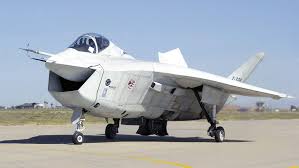✈️ Boeing X-32 — Review
🧩 Overview
The Boeing X-32 was developed in the late 1990s for the Joint Strike Fighter (JSF) competition — a program meant to create a multi-role, stealth-capable jet for the U.S. Air Force, Navy, and Marine Corps, as well as allied nations.
It competed directly against the Lockheed Martin X-35 (which became the F-35), and while it demonstrated many advanced features, it ultimately lost the contract. Still, the X-32 was a bold, futuristic design and a critical milestone in stealth fighter development.
⚙️ Specifications
-
First flight: September 18, 2000
-
Status: Canceled prototype
-
Crew: 1 (pilot)
-
Length: 43 ft (13.1 m)
-
Wingspan: 37 ft (11.3 m)
-
Max speed: Approx. Mach 1.6
-
Engine: 1 × Pratt & Whitney F119-PW-614 (thrust vectoring, shared with F-22)
-
Variants:
-
X-32A: Conventional takeoff and landing (CTOL)
-
X-32B: Short takeoff/vertical landing (STOVL)
-
(No actual production model)
-
🛠 Design Features
-
“Duckbill” nose: One of the X-32’s most distinctive features — made it look like a cartoonish or smiling jet
-
Large, single-piece delta wing: Provided strong lift and internal fuel space
-
Lift system (STOVL version): Used thrust vectoring and diverterless intake for short takeoff and vertical landing
-
Stealthy shape: Designed with stealth in mind but less refined than the X-35
-
Modular build: Aimed to be adaptable to different service needs (Air Force, Navy, Marines)
🧱 Strengths
-
Cost-efficient design: Boeing aimed to make it cheaper to build and maintain
-
Impressive early performance: The X-32A flew well and met most goals
-
Innovative one-piece wing: Reduced weight and simplified production
-
Good internal fuel capacity: Promised long range without external tanks
⚠️ Weaknesses
-
STOVL system was less capable: Compared to Lockheed’s shaft-driven lift fan, Boeing’s vectored-thrust method struggled with balance
-
Stealth shaping was inferior: The X-35 had a more refined radar signature
-
Cooling and heat management issues: Especially during hover testing
-
Less adaptable to Navy requirements: Carrier operations were more challenging
🏆 Why It Lost
In 2001, the Pentagon awarded the contract to Lockheed Martin’s X-35, which became the F-35 Lightning II. Reasons:
-
Lockheed’s lift fan system worked better for vertical landings
-
X-35 had more conventional aesthetics and stealth shaping
-
Easier to adapt to carrier-based operations
-
Performed better overall in operational tests
🏁 Final Verdict
| Category | Rating (★ out of 5) |
|---|---|
| Innovation | ★★★★☆ |
| Stealth Design | ★★★☆☆ |
| Flight Performance | ★★★★☆ |
| STOVL Capability | ★★☆☆☆ |
| Cool Factor | ★★★★☆ |
🔚 Final Thoughts
The Boeing X-32 was a bold, imaginative attempt to win the future of fighter aviation — but it was outmaneuvered by Lockheed Martin’s more refined, practical, and adaptable design. Still, the X-32 deserves respect as a formidable contender and a reminder that prototype designs often push the boundaries of what’s possible, even if they never make it to production.

Comments are closed